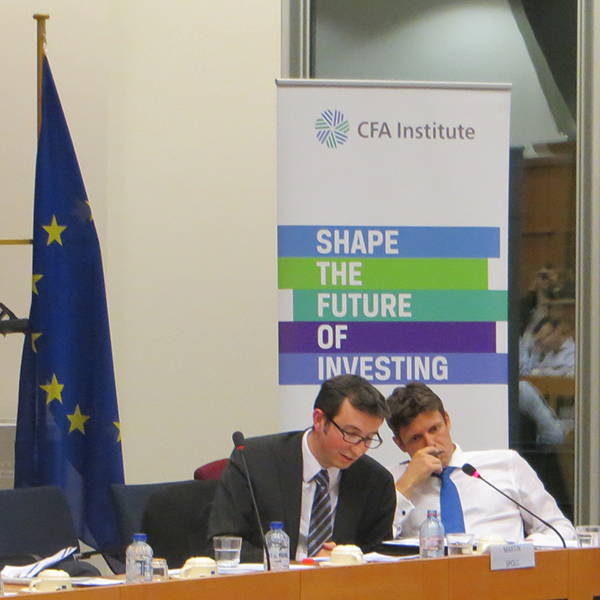The Orderly Resolution of Failing Banks: EU Policymakers Strike Compromise
After months of technical and political discussions, a compromise deal that should enable the orderly resolution of a bank, at least in theory, within 48 hours or a weekend has been reached in the European Union. The so-called “single resolution mechanism” (SRM) is the second leg of the European banking union project. It will affect all large and cross-border banks in the euro area that are about to become subject to the direct supervision of the European Central Bank (ECB).
It was against this backdrop that CFA Institute supported a recent CFA Society of Belgium event on the “Banking Union: Will It Prevent the Next Financial Crisis,” which happened to fall on the eve of the deal struck by the European Parliament, European Council, and European Commission, after more than 17 hours of negotiations. The discussion brought together Martin Špolc, CFA, deputy head of unit for banking structure reform at the European Commission; Wouter Coussens, head of the European Central Bank (ECB) representative office in Brussels; and Alberto Gallo, CFA, managing director and head of European macro credit research at the Royal Bank of Scotland (RBS). Hans Verbert, adviser for international and euro-system coordination at the National Bank of Belgium, moderated the debate. (Our deepest gratitude goes to Elisa Ferreira, member of the European Parliament in charge of the single resolution mechanism, for making this fruitful debate possible. The long negotiations kept her from participating in person.)
Martin Špolc, CFA, deputy head of unit for banking structure reform at the European Commission, and Wouter Coussens, head of the European Central Bank (ECB) representative office in Brussels, discuss the European banking union at a March event held at the European Parliament.
In analysing these recent developments, it’s clear the mechanism for decision-making is not ideal but better than some feared weeks ago. It involves the ECB, the European Commission, the European Council, and a resolution board composed of their representatives. In a best-case scenario, the ECB would recommend a resolution, the board would draft the resolution plan, and the European Commission would endorse it. The European Council, however, may oppose the plan, and any state aid would need to be separately approved by the European Commission.
The single resolution fund will be built and mutualised among member states gradually. The target is to reach 1% of covered deposits over eight years, or €55 billion, financed by the same banks it could rescue. Crucially, the fund will be able to borrow from the markets, which increases its credibility and firepower. It will initially have “national compartments,” but mutualisation has been front-loaded to reach 40% of the fund from its first year of existence.
On the Eve of the Deal: CFA Institute Members Hold Event at European Parliament
CFA Institute members had the opportunity to challenge the European Commission and the ECB on some of the assumptions and technical details surrounding the setup of the banking union during the lively debate at the European Parliament in the lead-up to approval of the single resolution mechanism. Špolc gave an informative presentation illustrating how different pieces of the banking union puzzle come together. A reformed European Banking Authority (EBA) will act as coordination link between the supervision carried out by the ECB, initially only within the euro area, and the work of those other national supervisors in Europe which chose to remain outside the single supervisory mechanism. Participants were confident that the banking union will increase the quality of supervision in Europe and facilitate its independence from narrow political interests such as the protection of national champions. As Coussens noted, the ECB’s comprehensive assessment and asset quality review should remove any remaining confusion from the European banking sector and offer the ECB more knowledge of the institutions it is about to supervise.
To break the vicious cycle between banks and sovereigns, a prominent feature of the crisis in Europe, more needs to be done. In particular, Gallo criticised the opportunity the Capital Requirements Directive (CRD) IV gives banks to optimise risk weights. He also noted that he still considered the levels of bank capitalisation far too low when compared, for instance, to industrial companies. While the banking structure reform would tend to segregate the most risky activities from deposit taking, the sheer size of the banking sector in Europe makes it unresolvable and calls for a long-term policy to develop capital markets. See additional research from Alberto Gallo and the presentation from the European Commission for more information.
Photo credit: iStockphoto.com/fcarucci


